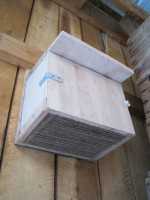Brown Marmorated Stink Bug: What’s In Store For 2013

It’s been a couple years since the brown marmorated stink big (BMSB) emerged as not just a nuisance for homeowners, but as a formidable threat to tree fruit production in many areas. The past two years have not been nearly as problematic as 2010, when the pest ravaged peach and apple orchards in the Mid-Atlantic region to the tune of near 100% crop loss in some areas. However, it is a constant threat to growers, and is beginning to show up in new locations (it generally takes about four years from being discovered to becoming a real problem).
In the past year, researchers from a wide range of institutions have attempted to learn more about how to monitor for BMSB and understand its movement patterns. In the meantime, questions remain about how much of an impact BMSB will have in 2013.
What We’ve Learned So Far
Perhaps the most important recent progress regarding monitoring BMSB, according to Virginia Tech entomologist Chris Bergh, has been the identification of its aggregation pheromone and a compound that, when used in combination with the pheromone, appears to synergize the response (i.e. captures). “This new monitoring capability will enable us to address important questions about when the bugs are present in the spring, when they become responsive to traps following emergence from overwintering sites, seasonal patterns of captures in relation to trap placement and adjacent habitat, and the relationship between captures and injury throughout the growing season, as well as any number of other questions about its behavioral response to baited traps or point sources of the pheromone and synergist,” says Bergh. In his lab, they generated preliminary data on patterns of adult emergence from artificial overwintering shelters in which bugs were forced to resettle before being deployed in unheated, unlighted buildings (e.g. barns and sheds) and in natural settings in woodlots. In the spring of 2012, they found that peak emergence from shelters in both locations occurred during the second half of May. A similar collaborative study between Bergh’s lab and USDA research entomologist Tracy Leskey’s lab is underway this year.
“We also demonstrated the utility of an overwintering shelter deployed in farm buildings and an attic known to have harbored overwintering BMSB in previous seasons,” says Bergh. The average number of adult BMSB recovered from five shelters deployed in different locations in late fall was 234, with a range of 14 to 664 per shelter. “These shelters should enable us to manipulate cohorts of overwintering bugs that voluntarily settled in them, and may prove to be a tool for mass removal of bugs seeking to overwinter in structures,” Bergh notes.
On the topic of management, Bergh says his team learned that seasons differ markedly. “We entered the 2012 season with lower BMSB pressure from fewer overwintering adults and also had a very early warm-up in March that translated to an earlier harvest and reduced duration of exposure to BMSB,” he says. “In combination, I think that these factors mitigated to some extent the impact of BMSB on tree fruit crops.” Furthermore, Bergh says many growers are doing a better job of intervening against BMSB with the tools available.
Greg Krawczyk, an entomologist at Penn State University, also weighs in on how management options have evolved. He says commercially available lures can be effective, but perhaps only in the second part of the season. “As of now, we still do not have any good lures (or traps) to monitor BMSB early in the season,” Krawczyk says.
From a management perspective, Krawczyk says pesticides are still the only effective tool for BMSB control, although different labs are coming up with some alternatives including exclusion, crop traps, and commercial light trapping. Biological control will help in the future, he says, but there is still no approval for the release of Asian parasitic wasps. “The best option would be if we can find something native,” he says. But so far nothing has presented itself.
Current Research
Leskey’s Agricultural Research Service lab in Kearneysville, WV, is focusing on the behavior, biology, and chemical ecology of BMSB. “We have worked very hard to identify olfactory and visual attractants for BMSB and develop effective monitoring tools,” she says. “We have studied dispersal capacity of BMSB, and we know they can easily fly 1 to 2 miles per day and they overwinter in the natural landscape. We are now studying their movement to and from overwintering sites.”
Bergh’s program is conducting the third and final year of a BMSB management demonstration trial in commercial orchards, refining and comparing a prescribed program with “grower standard” programs. “I also have several small-plot efficacy trials underway looking at the efficacy of seasonal programs and individual compounds,” he says.
Krawczyk says his program is focused primarily on monitoring and control methods. He cautions that growers should control only what they know they have. “With the available assortment of effective products, any other approach will create IPM disaster in our orchards,” Krawczyk says. “We are already seeing more woolly apple aphids, scale, and mites than ever before in our commercial orchards.”
Outlook For 2013
It may be too early to know for sure just how much of a presence BMSB will have in commercial tree fruit orchards in 2013. However, Bergh says that based on higher bugs captures in pheromone traps during the peak period of captures in 2012 than in 2011, as well as anecdotal reports of more bugs in people’s homes, he anticipates heavier pressure going into the 2013 season. “We are advising growers to remain vigilant going into this season,” says Bergh. One advantage that growers may have is the fact that overwintering adults seem to be more susceptible to a given rate of a given product than later generations of adults, which means there is a period during the first portion of the growing season when insecticide applications should hopefully perform well. “I think that there is growing consensus that the available tools should do an adequate job against BMSB in stone fruit, given the shorter fruiting period and generally less concern about using broad-spectrum products in the post-bloom period,” says Bergh. “The question remains, however, as to whether we can do an adequate job in mid- and late-season apples in a high-pressure year.”
Leskey says orchards in some areas are starting out with many more bugs this season than they did last season. “We know that means that early season crops like peaches will need to be protected,” she says. “But how populations do over the course of the season is still unknown.”
What about out West, where BMSB is just starting to show up? “In Oregon, I suspect more farms will have detectable levels of BMSB,” says Peter Shearer, an entomologist at Oregon State University. “We saw them in 2012 in vineyards, raspberries, hazelnuts, and blueberries. This was the first time we have seen them in commercial crops.” Last year, the occurrence was localized and in low numbers, Shearer notes. “This year they will probably affect more farms.”
The Potential Of Surround
A team of researchers at Rutgers University’s Snyder Research and Extension Farm in Pittstown, NJ, (with assistance from Wes Autio at the University of Massachusetts) has looked at the potential of Surround (kaolin clay) as a management option for brown marmorated stink bug (BMSB). If their trial results are successful, it may prove to be one of the only effective control options for organic growers.
The focus of the trials, which began in 2011, are on controlling BMSB at the end of the growing season, comparing insecticides with known activity against BMSB combined with Surround as compared to Surround alone as an untreated control. Early results did not indicate significant statistical differences; however, the team notes that, “It is our feeling that Surround can and does provide some level of repellency to BMSB on apples. We would like to see additional work with Surround on BMSB for this reason.”
To learn more about these trials, check out the Fall 2012 issue of “Horticultural News,” a publication of the New Jersey State Horticultural Society, at www.horticulturalnews.org.










